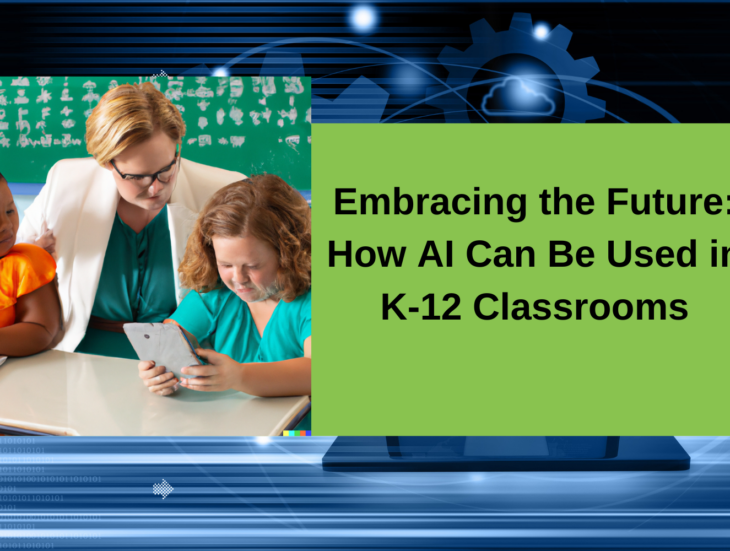
Artificial intelligence has been in the headlines as of late, even though we’ve been using it for years (think word prediction, spell check, Siri, Google Assistant and GPS). Chat GPT and Bard are two popular generative AI tools that can be harnessed for K-12 education!
Instead of writing a blog post about how to use AI in classrooms, we used Chat GPT and Bard to “write a 3 paragraph blog post for K-12 teachers about how AI can be used in the classroom.” Here is what the tools came up with:
Here is our finished product after the AI tools helped give us a jump start:
Embracing the Future: How AI Can Be Used in K-12 Classrooms
Artificial intelligence (AI) is rapidly transforming education, and K-12 teachers are increasingly using AI tools to enhance student learning. By harnessing the power of AI, educators can amplify their teaching strategies, cater to diverse student needs, and foster a more engaging and effective educational experience. Here are a few ways that AI can be used in the classroom:
- Personalized learning: AI can be used to create personalized learning experiences for each student. This can be done by tracking student progress, identifying areas of need, and providing targeted instruction. AI can also support professional learning for educators who are seeking to expand their knowledge or explore new topics and trends.
- Automated tasks: AI can be used to automate repetitive tasks, such as composing rubrics or creating lesson plans. This frees up teachers' time so they can focus on more important tasks, such as providing individualized attention to students.
- Instant feedback: AI can be used to provide instant feedback to students on assignments and projects. This empowers students to improve their work and take ownership of their learning journey.
- Virtual assistants: AI-powered virtual assistants can help students with tasks such as finding information, answering questions, and translating languages. This can free up students to focus on more creative and critical thinking tasks. When using virtual assistants students must think critically and use their prior knowledge to assure their prompt provides the appropriate output and content is accurate.
- Chatbots: AI chatbots can be used to provide students with personalized support and guidance. Chatbots can answer students' questions, provide feedback on their work, and even help them with their emotional well-being.
As we embrace AI's potential in education, it's important to remember that technology is a complement to, not a replacement for, the role of educators. Teachers remain at the heart of the classroom, guiding and mentoring students through their learning journeys. By incorporating AI in thoughtful and strategic ways, K-12 educators can create learning environments that are both innovative and student-centric, preparing our students to thrive in an AI-enhanced world.
Still a little hesitant to start using AI tools? Here are some tips for K-12 teachers who are considering using AI in the classroom to get started:
- Start small. There are many different AI tools available, so it's important to start with a tool that is appropriate for your students and your teaching style.
- Be clear about your goals. What do you hope to achieve by using AI in the classroom? Once you know your goals, you can choose an AI tool that is designed to meet those goals.
- Get feedback from students. Ask your students how they feel about using AI in the classroom. Are they comfortable with it? Are they finding it helpful?
- Be prepared to adapt. As you use AI in the classroom, you may need to adapt your teaching methods. Be open to new ideas and be willing to change your approach as needed.
AI is a powerful tool that can be used to enhance student learning. By using AI wisely, K-12 teachers can help their students prepare for a future that is increasingly driven by technology. Our team is here to support you on your path to embracing AI’s potential in your classroom. Each month the GWAEA Digital Learning Team will feature a classroom application for an AI to illustrate the multiple ways AI can be used. You can also listen to the EdTech Takeout Podcast with Charlotte Dungan from aiEDU or see the GWAEA Media Library for professional books around AI in the classroom to learn more.
About the Authors
Corey Rogers, Digital Learning Consultant
Stacy Behmer, Coordinator of Digital Learning & Media Services
- AI Credits:
- ChatGPT response to our prompt “write a 3 paragraph blog post for K-12 teachers about how AI can be used in the classroom.”
- Bard response to our prompt “write a 3 paragraph blog post for K-12 teachers about how AI can be used in the classroom.”
- Dall-E 2 image response to our prompt “k-12 classroom teacher utilizing AI with students”
